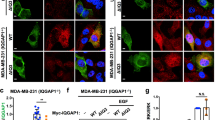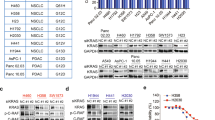Abstract
Cyclic adenosine 3′5′ monophosphate (cAMP) and protein kinase A (PKA) cooperate with phosphatidylinositol 3′ kinase (PI3K) signals in the control of growth and survival. To determine the molecular mechanism(s) involved, we identified and mutagenized a specific serine (residue 83) in p85αPI3K, which is phosphorylated in vivo and in vitro by PKA. Expression of p85αPI3K mutants (alanine or aspartic substitutions) significantly altered the biological responses of the cells to cAMP. cAMP protection from anoikis was reduced in cells expressing the alanine version p85αPI3K. These cells did not arrest in G1 in the presence of cAMP, whereas cells expressing the aspartic mutant p85D accumulated in G1 even in the absence of cAMP. S phase was still efficiently inhibited by cAMP in cells expressing both mutants. The binding of PI3K to Ras p21 was greatly reduced in cells expressing p85A in the presence or absence of cAMP. Conversely, expression of the aspartic mutant stimulated robustly the binding of PI3K to p21 Ras in the presence of cAMP. Mutation in the Ser 83 inhibited cAMP, but not PDGF stimulation of PI3K. Conversely, the p85D aspartic mutant amplified cAMP stimulation of PI3K activity. Phosphorylation of Ser 83 by cAMP–PKA in p85αPI3K was also necessary for estrogen signaling as expression of p85A or p85D mutants inhibited or amplified, respectively, the binding of estrogen receptor to p85α and AKT phosphorylation induced by estrogens. The data presented indicate that: (1) phosphorylation of Ser 83 in p85αPI3K is critical for cAMP–PKA induced G1 arrest and survival in mouse 3T3 fibroblasts; (2) this site is necessary for amplification of estrogen signals by cAMP–PKA and related receptors. Finally, these data suggest a general mechanism of PI3K regulation by cAMP, operating in various cell types and under different conditions.
This is a preview of subscription content, access via your institution
Access options
Subscribe to this journal
Receive 50 print issues and online access
$259.00 per year
only $5.18 per issue
Buy this article
- Purchase on Springer Link
- Instant access to full article PDF
Prices may be subject to local taxes which are calculated during checkout







Similar content being viewed by others
References
Affaitati A, Cardone L, de Cristofaro T, Carlucci A, Ginsberg MD, Varrone S et al. (2003). Essential role of A-kinase anchor protein 121 for cAMP signaling to mitochondria. J Biol Chem 278: 4286–4294.
Alvarez B, Garrido E, Garcia-Sanz JA, Carrera AC . (2003). Phosphoinositide 3kinase activation regulates cell division time by coordinated control of cell mass and cell cycle progression rate. J Biol Chem 278: 26466–26473.
Ariga M, Nedachi T, Akahori M, Sakamoto H, Ito Y, Hakuno F et al. (2000). Signalling pathways of insulin-like growth factor-I that are augmented by cAMP in FRTL-5 cells. Biochem J 348(Part 2): 409–416.
Aronica SM, Kraus WL, Katzenellenbogen BS . (1994). Estrogen action via the cAMP signaling pathway: stimulation of adenylate cyclase and cAMP-regulated gene transcription. Proc Natl Acad Sci USA 91: 8517–8521.
Castoria G, Migliaccio A, Bilancio A, Di Domenico M, de Falco A, Lombardi M et al. (2001). PI3Kinase in concert with Src promotes the S-phase entry of oestradiol-stimulated MCF-7 cells. EMBO J 20: 6050–6059.
Ciullo I, Diez-Roux G, Di Domenico M, Migliaccio A, Avvedimento EV . (2001). cAMP signaling selectively influences Ras effectors pathways. Oncogene 20: 1186–1192.
Cui Y, Zhang M, Pestell R, Curran EM, Welshons WV, Fuqua SA . (2004). Phosphorylation of estrogen receptor alpha blocks its acetylation and regulates estrogen sensitivity. Cancer Res 64: 9199–9208.
De Gregoria G, Coppa A, Cosentino C, Ucci S, Messina S, Nicolussi A et al. (2006). The p85 regulatory subunit of PI3K mediates TSH-cAMP-PKA growth and survival signals. Oncogene, in press.
Feliciello A, Gallo A, Mele E, Porcellini A, Troncone G, Garbi C et al. (2000). The localization and activity of cAMP-dependent protein kinase affect cell cycle progression in thyroid cells. J Biol Chem 275: 303–311.
Frisch SM, Francis H . (1994). Disruption of epithelial cell–matrix interactions induces apoptosis. J Cell Biol 124: 619–626.
Houslay MD, Kolch W . (2000). Cell-type specific integration of cross-talk between extracellular signal-regulated kinase and cAMP signaling. Mol Pharmacol 58: 659–668.
Kato JY, Matsuoka M, Polyak K, Massague J, Sherr CJ . (1994). Cyclic AMP-induced G1 phase arrest mediated by an inhibitor (p27Kip1) of cyclin-dependent kinase 4 activation. Cell 79: 487–496.
Khwaja A, Rodriguez-Viciana P, Wennstrom S, Warne PH, Downward J . (1997). Matrix adhesion and Ras transformation both activate a phosphoinositide 3-OH kinase and protein kinase B/Akt cellular survival pathway. EMBO J 16: 2783–2793.
Knecht M, Darbon JM, Ranta T, Baukal AJ, Catt KJ . (1984). Estrogens enhance the adenosine 3′,5′-monophosphate-mediated induction of follicle-stimulating hormone and luteinizing hormone receptors in rat granulosa cells. Endocrinology 115: 41–49.
Kurokawa K, Kato J . (1998). Cyclic AMP delays G2 progression and prevents efficient accumulation of cyclin B1 proteins in mouse macrophage cells. Cell Struct Funct 23: 357–365.
Lee YH, Park JS, Park CH, Lee SK . (1998). Synergistic effect of cyclic AMP and insulin on the expression of cyclin A gene in Swiss 3T3 cells. Biochem Biophys Res Commun 244: 843–848.
Magnaldo I, Pouyssegur J, Paris S . (1989). Cyclic AMP inhibits mitogen-induced DNA synthesis in hamster fibroblasts, regardless of the signalling pathway involved. FEBS Lett 245: 65–69.
Maier U, Babich A, Nürnberg B . (1999). Roles of non-catalytic subunits in gbetagamma-induced activation of class I phosphoinositide 3Kinase isoforms beta and gamma. J Biol Chem 274: 29311–29317.
Pastan IH, Johnson GS, Anderson WB . (1975). Role of cyclic nucleotides in growth control. Annu Rev Biochem 44: 491–522.
Porcellini A, Messina S, De Gregorio G, Feliciello A, Carlucci A, Barone M et al. (2003). The expression of the thyroid-stimulating hormone (TSH) receptor and the cAMP-dependent protein kinase RII beta regulatory subunit confers TSH-cAMP-dependent growth to mouse fibroblasts. J Biol Chem 278: 40621–40630.
Rohde JR, Campbell S, Zurita-Martinez SA, Cutler NS, Ashe M, Cardenas ME . (2004). TOR controls transcriptional and translational programs via Sap-Sit4 protein phosphatase signaling effectors. Mol Cell Biol 24: 8332–8341.
Simoncini T, Hafezi-Moghadam A, Brazil DP, Ley K, Chin WW, Liao JK . (2000). Interaction of oestrogen receptor with the regulatory subunit of phosphatidylinositol-3-OH kinase. Nature 407: 538–541.
Zurita-Martinez SA, Cardenas ME . (2005). Tor and cyclic AMP-protein kinase A: two parallel pathways regulating expression of genes required for cell growth. Eukaryot Cell 4: 63–71.
Acknowledgements
This work was partly supported by AIRC (Associazione Italiana Ricerca Cancro), NOGEC (Naples Oncogenomic Center), MIUR (Italian Ministry of Education, University and Research). Concetta Cuozzo is a recipient of an FIRC Fellowship. This work is dedicated to the loving memory of Stelio Varrone.
Author information
Authors and Affiliations
Corresponding author
Additional information
Supplementary Information accompanies the paper on the Oncogene website (http://www.nature.com/onc).
Supplementary information
Rights and permissions
About this article
Cite this article
Cosentino, C., Di Domenico, M., Porcellini, A. et al. p85 regulatory subunit of PI3K mediates cAMP–PKA and estrogens biological effects on growth and survival. Oncogene 26, 2095–2103 (2007). https://doi.org/10.1038/sj.onc.1210027
Received:
Revised:
Accepted:
Published:
Issue Date:
DOI: https://doi.org/10.1038/sj.onc.1210027
Keywords
This article is cited by
-
Mitochondrial cAMP signaling
Cellular and Molecular Life Sciences (2016)
-
Mechanism of sperm capacitation and the acrosome reaction: role of protein kinases
Asian Journal of Andrology (2012)
-
Overexpression of 14-3-3ζ in cancer cells activates PI3K via binding the p85 regulatory subunit
Oncogene (2012)
-
Phosphodiesterase III Inhibition Increases cAMP Levels and Augments the Infarct Size Limiting Effect of a DPP-4 Inhibitor in Mice with Type-2 Diabetes Mellitus
Cardiovascular Drugs and Therapy (2012)
-
The p85 regulatory subunit of PI3K mediates TSH–cAMP–PKA growth and survival signals
Oncogene (2007)



